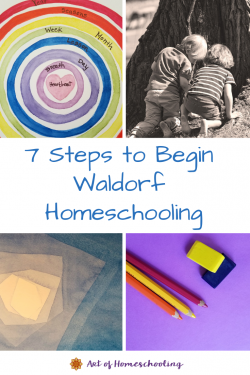Getting Started with Waldorf Homeschooling
Welcome to the amazing journey of homeschooling! I want to help you navigate getting started with Waldorf homeschooling. Or getting started with homeschooling no matter what your situation is.
Here’s my concise description of the Waldorf approach:
Waldorf education is a developmental approach to learning that incorporates rhythm and the arts into all lessons.
Not even sure what that means? No worries, I’ve got you covered!
Keep in mind…this is as much a path of growth and discovery for you as it will be for your children. 🙂
And I’m here to help you get started so you can feel more relaxed, present, and connected with your children.
As a homeschooling mentor, I am asked all the time, “Where do I start?”
If you’re wondering that too, you’re in the right place!
This page will give you 7 first steps to take, plus a basic supplies and resources list so you can begin bringing the magic of Waldorf to your children and family right away.

Getting Started with Waldorf Homeschooling
1. Start Where You Are!
Honestly, wherever you are on the homeschooling journey and in your understanding of the Waldorf method is just fine. You will learn as you go just like we all have.
I like to say, “Think in threes, pick one.” So find three things from this article that you want to implement and then start with the first one!
Starting where you are also includes looking at your child’s current needs and stage of development. Get the Waldorf Homeschool Starter Kit for the simplest way to start homeschooling today!
2. Embrace Rhythm
Rather than expect perfectly planned and executed lessons, start with creating a steady rhythm for your family.
- Yearly rhythm includes seasonal celebrations & festivals
- Weekly rhythm includes, for example, different activities on different days such as painting on Mondays or baking bread on Wednesdays
- Daily rhythm includes meals, chores, lessons, bedtime
For more on rhythm, get my FREE Waldorf Rhythm Quickstart Guide.
3. Enjoy the Journey
You don’t want to rush through daily life activities just to get to the lessons. The whole of your day and how it happens is a lesson in itself!
So make a simple plan for chores and a simple plan for meals, and then involve your whole family. Enjoy the journey!
4. Spend Time Outdoors
Unstructured time in nature is so nurturing. The flexibility of homeschooling allows us to build our days around what’s best for our children (and for us!).

You might like to create a Nature Table where you bring some items from your nature walks indoors to create a seasonal display.
5. Read Stories Every Day
Stories form the foundation of our lessons. All kinds of stories – about nature, animals, the seasons, good people, etc.
Try telling or reading a story one day. Then on the next day, retell the story, act it out, paint, draw, or model something from the story.
Our literature guides can help you create a main lesson block around one great read-aloud! Check out our Book Hearth Guides here.
6. Weave in the Lively Arts
Waldorf education incorporates the arts into lessons and life ~ drawing, movement, music, drama, modeling, painting, and speech. All in addition to stories, of course!
If you want specific, actionable ideas for how to weave the arts into your lessons, click here to get Weaving the Arts into Homeschooling. It’s free!
7. Find Community
Whether in your neighborhood or at a distance, finding other homeschoolers on this journey can make all the difference. So find your tribe!
If you would love community support from the convenience of your own home, please check out the Inspired at Home mentorship community. With monthly masterclasses and coaching calls for reflection and planning, you can get the support you need along with inspiration, along with a community of like-minded homeschoolers to sustain you. Get skilled in the Waldorf approach at your own pace and customize whatever resources you have to suit your family.
You CAN homeschool your children with Waldorf.
Just remember to keep it simple with these 7 steps. Here’s how I can help.
Above all, enjoy the journey!



